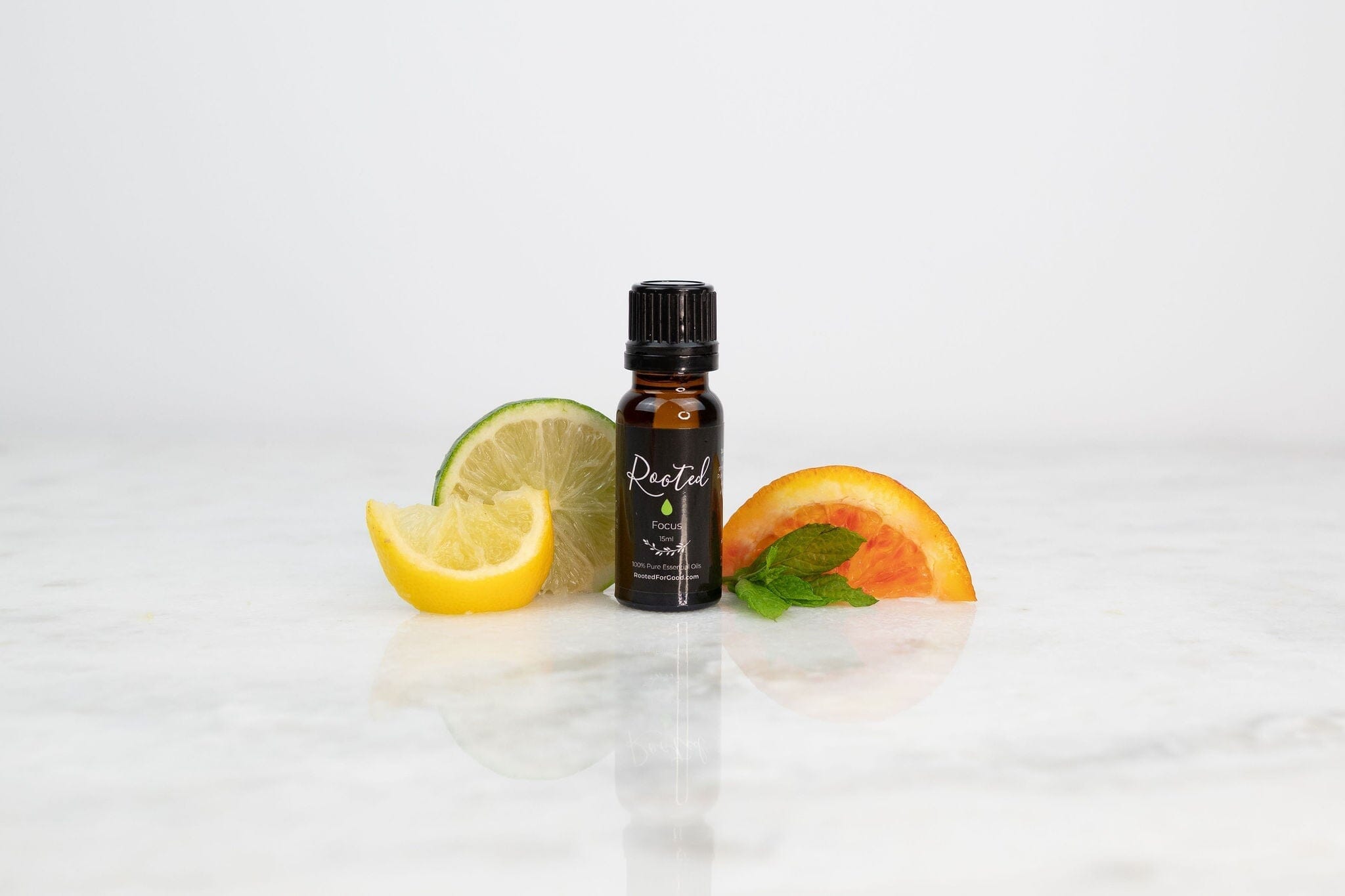Key Takeaways
- Morning sickness can be intense and challenging to manage during early pregnancy.
- It is important to be cautious about what products are applied to the body during pregnancy.
- Properly diluted essential oils, such as lemon and peppermint, can provide safe relief for pregnancy nausea.
- Inhalation is an effective method to use essential oils for easing morning sickness symptoms.
- Combining personal experience with professional knowledge can help find gentle solutions for pregnancy discomforts.
Table of Contents
- How Essential Oils Work for Pregnancy Nausea: The Gentle Science
- Which Essential Oils Actually Work: Evidence-Based Options
- How to Use Essential Oils Safely During Pregnancy: Step-by-Step
- Comparison: Essential Oil Options vs. Other Nausea Remedies
- The Rooted For Good Philosophy: Why Ingredients Matter for Expecting Moms
- How to Use Essential Oils Safely for Pregnancy Nausea
- When Essential Oils Don't Work: Honest Troubleshooting
- Essential Oils vs. Other Natural Remedies: What Works Best
- Why Ingredient Transparency Matters for Expecting Moms
- Creating Your Safe Essential Oil Routine
Essential Oil for Pregnancy Nausea: Honest Answers & Gentle Solutions from a Mom and Cosmetologist
When I was pregnant with my third son, morning sickness hit me like a freight train at 6 weeks. As a licensed cosmetologist, I knew exactly what not to put on my body, but finding safe, effective relief for pregnancy nausea felt overwhelming. That's when I discovered the power of properly diluted essential oil for pregnancy nausea, specifically lemon and peppermint oils used through inhalation.
Over 70% of pregnant women experience nausea, yet many safe conventional treatments are limited. After years of formulating clean skincare for my family of eight, I've learned that transparency and gentle effectiveness matter most, especially for expecting moms. Every product we create is handcrafted with 100% natural ingredients and therapeutic-grade essential oils, no toxins, no fillers, no vague labels.
If you're looking for a convenient way to experience the benefits of aromatherapy, an AromaCloud Diffuser can make it easy to use essential oils safely at home.
How Essential Oils Work for Pregnancy Nausea: The Gentle Science
Pregnancy nausea stems from fluctuating hormones (especially hCG), digestive changes, and heightened senses. When you inhale specific essential oils, volatile compounds activate scent receptors that send calming signals directly to your brain's nausea center and digestive system.
Research shows that essential oil for pregnancy nausea works through the olfactory pathway, bypassing your digestive system entirely. A 2014 clinical study found that women who inhaled lemon essential oil experienced significant nausea reduction compared to placebo groups, with relief often occurring within 2-3 minutes.
Inhalation remains the safest method during pregnancy because it provides fast action with minimal systemic exposure. Unlike topical application or ingestion, breathing diluted oils poses virtually no risk to developing babies when used properly.
Which Essential Oils Actually Work: Evidence-Based Options
| Essential Oil | Research Support | How It Helps | Safety in Pregnancy | Best Application |
|---|---|---|---|---|
| Lemon | Strong clinical evidence | Reduces nausea intensity, uplifts mood | Safe for inhalation | Cotton ball, diffuser |
| Peppermint | Moderate evidence | Cooling sensation, digestive comfort | Safe when properly diluted | Inhalation, diluted topical |
| Ginger | Traditional use, some studies | Settles stomach, anti-nausea properties | Safe for inhalation/topical | Diffuser, roll-on blend |
| Sweet Orange | Limited studies | Calms anxiety, mood support | Safe for inhalation | Diffuser only |
At Rooted For Good, we use only therapeutic-grade oils with complete transparency. Every ingredient is listed with its botanical name, no "fragrance" or proprietary blends. Our plant-based carrier oils include sweet almond and jojoba, chosen specifically for their gentle, nourishing properties during pregnancy.
What we intentionally leave out matters just as much: no synthetic preservatives, no undisclosed chemicals, and absolutely no oils that aren't proven safe for expecting mothers.
How to Use Essential Oils Safely During Pregnancy: Step-by-Step
Inhalation Method (Most Recommended): Place 1-2 drops of lemon or properly diluted peppermint oil on a cotton ball. Hold 3-4 inches from your nose and breathe gently for 1-2 minutes. This method provides the fastest relief with zero risk of skin irritation.
Diffuser Application: Add 2-3 drops total to a water-based diffuser in a well-ventilated room. Run for 15-30 minutes maximum to avoid scent fatigue. Never use ultrasonic diffusers in small, enclosed spaces during pregnancy.
Topical Use (When Properly Diluted): If you choose to make a topical dilution, keep it conservative at about 0.5–1% (roughly 1 drop essential oil per 10 ml carrier) and apply to inner wrists only. Patch test first and discontinue if irritation occurs.
Critical Safety Rules: Never ingest essential oils during pregnancy. Always patch test new dilutions 24 hours before full use. Stop immediately if you experience headaches, increased nausea, or skin irritation. Consult your healthcare provider if symptoms persist.
Comparison: Essential Oil Options vs. Other Nausea Remedies
When you're dealing with pregnancy nausea, you want relief that's safe, effective, and fits your real life. As a mom of six boys, I've learned that not all remedies work the same way, or at all, for every woman. Here's how essential oil for pregnancy nausea stacks up against other common options, based on safety, speed of relief, and practical use for busy families.
| Remedy Type | Safety in Pregnancy | Speed of Relief | Ingredient Clarity | Portability | Cost Range |
|---|---|---|---|---|---|
| Lemon + Peppermint Oil (Inhalation) | High when properly diluted | Within 2-5 minutes | 100% transparent | Excellent (very portable) | $15-25 |
| Ginger Tea | High | 15-30 minutes | Transparent | Requires preparation | $5-12 |
| OTC Anti-nausea Medications | Varies by type | 30-60 minutes | Listed but complex | Good | $8-20 |
| Acupressure Bands | Very high | Variable results | N/A | Excellent | $10-15 |
Research shows that lemon and peppermint essential oils, when used for inhalation, can reduce nausea intensity faster than placebo treatments. The key advantage is immediate availability, no brewing, no swallowing pills when your stomach is already upset. At Rooted For Good, we focus on simple, clearly labeled single oils and clean carriers—no mystery ingredients—so you can keep things minimal and transparent.
The transparency factor matters most to me as both a cosmetologist and a mom. You know exactly what you're breathing in: pure lemon oil, peppermint oil, and plant-based carrier oils. No hidden fragrances, no synthetic additives, no wondering what's actually in that "natural flavor" on other products.
The Rooted For Good Philosophy: Why Ingredients Matter for Expecting Moms
When I started this three-month challenge to use only natural products for our family of eight, I quickly realized that "natural" on a label doesn't always mean what you think it means. As a licensed cosmetologist, I knew how to read ingredient lists, but as a pregnant mom, I needed products I could trust completely, no guessing, no research required, just honest ingredients that work.
Clarifying note: We do not sell a proprietary “pregnancy nausea” blend. When using aromatherapy for queasiness, we recommend keeping it simple with clearly labeled single oils—like therapeutic-grade lemon or peppermint—so you always know exactly what you’re using. No "fragrance" or "proprietary blend" hiding potentially harmful chemicals. This transparency protects you and your developing baby from accidental exposure to toxins or allergens you didn't even know were there.
Family-run and mission-driven means every formula is tested by real families, including mine. When you're dealing with pregnancy nausea, the last thing you need is wondering whether your relief method is adding stress to your body. Conservative dilutions and short inhalation sessions mean effective support without overexposure, even for sensitive skin or heightened pregnancy senses.
Beyond your own family's wellness, 10% of every sale supports transformation projects, clean water access, safe housing, and economic opportunities for families in need. Care that extends far beyond your own home, rooted in our faith-driven mission to spread goodness wherever possible.
How to Use Essential Oils Safely for Pregnancy Nausea
Safety comes first, especially when you're expecting. Here's exactly how to use essential oil for pregnancy nausea effectively without risking overexposure or irritation. These methods work for busy moms who need relief that fits real life, no complicated routines or lengthy preparation.
Inhalation Method (Most Recommended): Apply 1-2 drops of a single oil (lemon or peppermint) to a tissue or cotton swab, then cup near your nose and breathe slowly for 30-60 seconds. Relief often begins within 2-5 minutes. You can repeat this up to 4 times daily as needed. For diffuser use, add 2-3 drops to water and run for 15-30 minutes in a well-ventilated space.
Topical Application Guidelines: If you decide to use a topical dilution, keep it very light—about 0.5–1%—and apply to pulse points (wrists, behind ears). Avoid broken skin or mucous membranes. Always patch test for 12-24 hours before full use, even with properly diluted oils.
Timing and Frequency: Use at the first sign of nausea rather than waiting until it peaks. Most women find relief within minutes of inhalation. Space applications at least 30 minutes apart to avoid overwhelming your senses.
For more tips and a deeper dive into the topic, read our guide on essential oil for nausea.
When Essential Oils Don't Work: Honest Troubleshooting
Not every essential oil for pregnancy nausea works for every mom, and that's completely normal. Your body is changing daily, and what helps today might not tomorrow.
If nausea worsens: Stop immediately and switch to plain fresh air. Some pregnant women develop temporary scent sensitivities that make any fragrance overwhelming. Try a different oil after 24 hours, or stick to single oils rather than blends.
No relief after consistent use: Essential oils help about 60-70% of women with mild to moderate nausea. If you've tried lemon, peppermint, and ginger oils properly diluted for a week with no improvement, your nausea may need different support, ginger tea, acupressure bands, or a conversation with your healthcare provider.
Red Flags to Stop Use: Skin irritation, headaches, dizziness, or breathing changes. Pregnancy isn't the time to push through adverse reactions.
Managing multiple children while using oils: Diffuse in your bedroom rather than common areas, and keep oils out of reach. Children shouldn't apply undiluted oils, but gentle diffusion won't harm them.
Essential Oils vs. Other Natural Remedies: What Works Best
As a mom of six boys, I've tried every safe nausea remedy available. Here's how essential oil for pregnancy nausea stacks up against other natural options:
| Remedy | Speed of Relief | Convenience | Safety Profile | Cost |
|---|---|---|---|---|
| Lemon + Peppermint Oil (Rooted For Good) | 1-3 minutes | Portable (tissue/cotton) | High when properly diluted | Moderate |
| Ginger Tea | 15-30 minutes | Requires preparation | Very high | Low |
| Sea-bands (Acupressure) | Variable | Wear all day | Very high | Low |
| Vitamin B6 | Days to weeks | Daily pill | High with dosage limits | Low |
The advantage of quality essential oils: Immediate relief you can carry anywhere. When morning sickness hits in the grocery store or during school pickup, a single drop on a tissue provides instant support.
Best combination approach: Many moms find success layering remedies, wearing sea-bands daily, sipping ginger tea, and using essential oil for pregnancy nausea during acute episodes.
For more ways to support your overall wellness with essential oils, check out our article on using these 3 essential oils for overall health and wellness.
For a clinical perspective on aromatherapy and nausea, see this peer-reviewed study on essential oils for nausea.
Why Ingredient Transparency Matters for Expecting Moms
During my bucket-list challenge to use only natural products for our family of eight, I discovered how many "natural" brands hide ingredients behind vague terms like "fragrance" or "proprietary blend." When you're pregnant, you deserve to know exactly what touches your skin.
Our promise: Every Rooted For Good formula lists each ingredient with its botanical name and purpose. No mystery chemicals, no synthetic preservatives, no fillers that serve the manufacturer instead of your family.
What's in our pregnancy-conscious approach: Clearly labeled single essential oils like therapeutic-grade lemon and peppermint, and gentle plant-based carriers like sweet almond and jojoba. Simple, recognizable ingredients your grandmother would understand.
What's intentionally left out: Parabens, sulfates, synthetic fragrances, and any essential oils not proven safe during pregnancy. We never include risky botanicals or untested combinations.
Creating Your Safe Essential Oil Routine
The best essential oil for pregnancy nausea routine is one you'll actually use consistently. Here's the simple approach that works for busy moms:
Morning preparation: Keep lemon or peppermint handy on your nightstand. Before getting out of bed, place 1 drop on a tissue and take a few gentle breaths—this can prevent the rush of nausea that often hits when you first stand up.
On-the-go relief: Carry a small sealed cotton swab or tissue with 1 drop of your preferred oil in a mini zip bag. Open only when needed and inhale briefly.
Evening wind-down: If nausea worsens with fatigue, diffuse gentle lemon oil in your bedroom for 20 minutes before sleep. This can help prevent middle-of-the-night queasiness.
Frequency guidelines: Use as needed, up to 4 times daily. Space sessions at least 30 minutes apart to avoid scent fatigue. Listen to your body—some days you'll need more support, others less.
For a complete selection of single oils, explore the Single Essential Oils Starter Kit for options you can use throughout your routine.
Frequently Asked Questions
How do essential oils like lemon and peppermint help relieve pregnancy nausea?
Lemon and peppermint essential oils work by activating scent receptors that send calming signals to the brain’s nausea center, helping ease queasiness without involving the digestive system. Their refreshing aromas can provide gentle relief when inhaled properly diluted.
What is the safest way to use essential oils during pregnancy to manage morning sickness?
The safest way is to use properly diluted essential oils through inhalation, such as with a diffuser or a few drops on a tissue, avoiding direct skin application unless guided by a professional. This method minimizes risk while offering effective relief.
Are there any essential oils that should be avoided during pregnancy due to safety concerns?
Yes, some essential oils are not recommended during pregnancy because they may cause adverse effects. It’s important to avoid oils known for stimulating contractions or toxicity and always consult a healthcare provider before use.
How do essential oils compare to other natural or conventional remedies for pregnancy-related nausea?
Essential oils offer a gentle, non-invasive option that works through scent rather than ingestion, making them a good complement or alternative to other remedies. While conventional treatments may be limited, essential oils can provide safe, soothing support when used properly.





